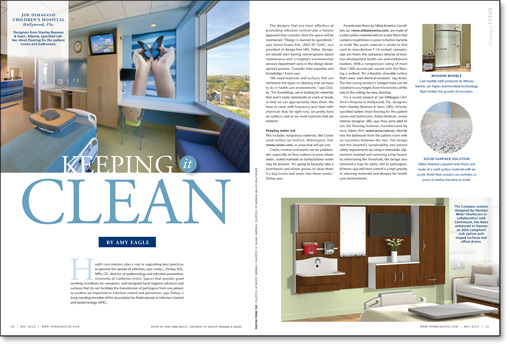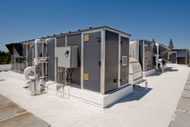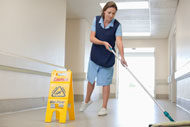
Click the above image for a PDF download
Health care interiors play a role in supporting best practices to prevent the spread of infection, says Linda L. Dickey, R.N., MPH, CIC, director of epidemiology and infection prevention, University of California–Irvine. Spaces that provide good working conditions for caregivers, well-designed hand hygiene solutions and surfaces that do not facilitate the transmission of pathogens from one person to another are important to infection control and prevention, says Dickey, a long-standing member of the Association for Professionals in Infection Control and Epidemiology (APIC).
The designs that are most effective at promoting infection control take a holistic approach that considers how the space will be maintained. "Design is married to operations," says Jennie Evans, R.N., LEED AP, EDAC, vice president at design firm HKS, Dallas. Designers should start having conversations about maintenance with a hospital's environmental services department early in the design development process. "Consider their expertise and knowledge," Evans says.
"We need materials and surfaces that can withstand the types of cleaning that we have to do in health care environments," says Dickey. "For furnishings, we're looking for materials that won't easily deteriorate or crack or break, so that we can appropriately clean them. We have to clean with frequency and clean with chemicals that, for right now, are pretty hard on surfaces, and so we need materials that are resilient."
Keeping water out
This includes nonporous materials, like Corian solid surface by DuPont, Wilmington, Del. (www.corian.com), in areas that will get wet.
Cracks, crevices and seams can be problematic, especially on floor surfaces in areas where water, soiled materials or biohazardous waste may be present. "It's going to basically take a toothbrush and elbow grease to clean them if a bag bursts and seeps into those seams," Dickey says.
Poured resin floors by Silikal America, Carrollton, Ga. (www.silikalamerica.com), are made of a solid surface material with an acrylic finish that contains no pinholes or pores to harbor bacteria or mold. The acrylic material is similar to that used to manufacture F-16 cockpit canopies, says Jon Knorr, the company's director of business development, health care and institutional markets. With a compression rating of more than 7,000 pounds per square inch, the flooring is resilient. "It's a durable, cleanable surface that's wear- and chemical-resistant," says Knorr. The fast-curing product's integral base can be installed to any height, from 4 to 6 inches all the way to the ceiling, for easy cleaning.
For a recent project at Joe DiMaggio Children's Hospital in Hollywood, Fla., designers from Stanley Beaman & Sears (SBS), Atlanta, specified rubber sheet flooring for the patient rooms and bathrooms. Robin Kirkman, senior interior designer, SBS, says they were able to run the flooring material, manufactured by nora, Salem, N.H. (www.nora.com/us), directly into the bathroom from the patient room with no transition between the two. This design met the hospital's sustainability and patient safety requirements by using a renewable, slip-resistant material and removing a trip hazard; by eliminating the threshold, the design also removed a trap for spills, dirt or pathogens. Kirkman says infection control is a high priority in selecting materials and designs for health care environments.
The materials used to manufacture the modular Compass system by Herman Miller Healthcare, a subsidiary of Herman Miller Inc., Zeeland, Mich. (www.hermanmiller.com), were carefully selected and shaped so the pieces have no cracks or crevices to collect germs, says Joel VanWyk, director of product management for health care, Herman Miller. The components fit together in an overlapping fashion, like shingles on a roof, to prevent debris from getting between them. The system is wall-mounted, to make it easy to clean beneath. The installation process seals the pieces off from the wall completely, "as if you've caulked the product to the wall," VanWyk says. The entire system can be disassembled for thorough cleaning, if necessary.
Inhibiting growth
Agion antimicrobial technology by Sciessent, Wakefield, Mass. (www.agion-tech.com), uses silver ions, which are embedded in or applied to the surface of a product, to inhibit the growth of microbes. Paul Ford, CEO, Agion, says the technology has been tested according to ASTM International (formerly American Society for Testing and Materials) standards for antimicrobial efficacy in textiles (ASTM E2149) and hard surface materials (ASTM E2180). Textiles by CF Stinson Inc., Rochester Hills, Mich. (www.cfstinson.com), and cast marble bath products by Mincey Marble Manufacturing Inc., Gainesville, Ga. (www.minceymarble.com), are among the products using Agion technology.
Sharklet Technologies Inc., Aurora, Colo. (www.sharklet.com), has developed a surface pattern that mimics that of sharkskin, which the company says is naturally resistant to microbial growth. The pattern is available on Tactivex, a film designed to reduce bacterial contamination of surfaces, which can be applied to surfaces in the health care environment. It is distributed by LGInternational Inc., Portland, Ore. (www.tactivex.com).
Washing up
The placement and design of hand-washing sinks also can contribute to infection control. According to Dickey, hand-washing sinks should be located at the point of use, in consistent locations. They should be easily accessible and placed where splashing from the sink will not create a contamination hazard.
Debby Gross, NCIDQ, associate in the Pittsburgh office of design firm Stantec, says hand-washing sinks can be a well-thought-out component of a patient room. At Wheeling (W.Va.) Hospital, Stantec designers specified wall-mounted, hand-washing sinks as an economical alternative to casework. Porcelain tile protects the wall from moisture and adds color and pattern to the room design.
Dispensers for waterless hand sanitizers, like the gel or foam dispensers by Ecolab Inc., Saint Paul, Minn. (www.ecolab.com), can be installed without regard to the location of plumbing, making these a convenient option for health care interior design. They are also convenient for caregivers, as they do not have to stop at a sink to use them, says Evans, of HKS. The 20 seconds it takes to wash hands properly "is a long period of time to a clinician," Evans says.
Using a small, wall-mounted monitor near the hand-washing sink or waterless hand sanitizer dispenser, and another small monitor near the patient bed, the monitoring system by HyGreen Inc., Gainesville, Fla. (www.hygreen.com), can remind caregivers to clean their hands and automatically records their hand-washing status. The objective information recorded by such a system could be helpful in increasing hand-hygiene compliance, says Dickey.





